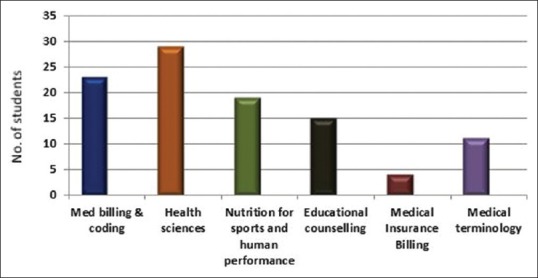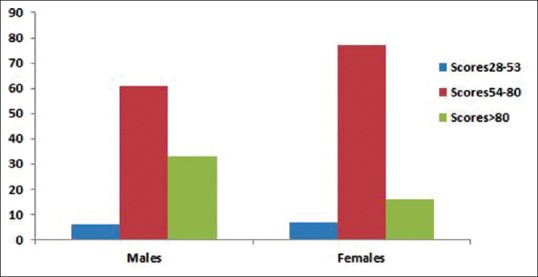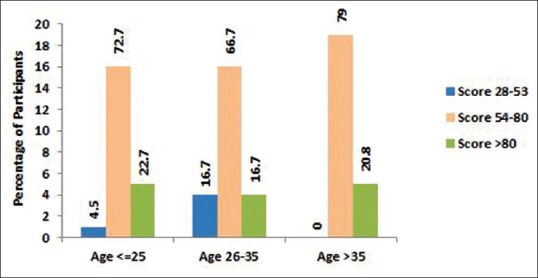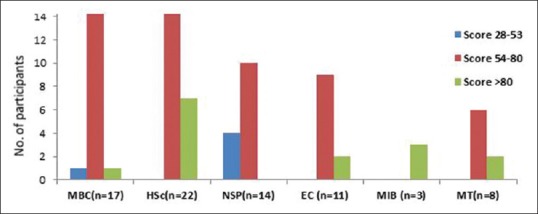Abstract
Background:
Blended learning (BL) is defined as “a way of meeting the challenges of tailoring learning and development to the needs of individuals by integrating the innovative and technological advances offered by online learning with the interaction and participation offered in the best of traditional learning.” The Gulf Medical University (GMU), Ajman, UAE, offers a number of courses which incorporate BL with contact classes and online component on an E-learning platform. Insufficient learning satisfaction has been stated as an obstacle to its implementation and efficacy.
Aim:
To determine the students’ perceptions toward BL which in turn will determine their satisfaction and the efficacy of the courses offered.
Subjects and Methods:
This was a cross-sectional study conducted at the GMU, Ajman between January and December 2013. Perceptions of BL process, content, and ease of use were collected from 75 students enrolled in the certificate courses offered by the university using a questionnaire. Student perceptions were assessed using Mann–Whitney U-test and Kruskal–Wallis test on the basis of gender, age, and course enrollment.
Results:
The median scores of all the questions in the three domains were above three suggesting positive perceptions on BL. The distribution of perceptions was similar between gender and age. However, significant differences were observed in the course enrollment (P = 0.02).
Conclusion
Students hold a positive perception of the BL courses being offered in this university. The difference in perceptions among students of different courses suggest that the BL format offered needs modification according to course content to improve its perception.
Keywords: Blended learning, Online learning, Students’ perceptions
Introduction
Internet-based technologies and other advanced computer software are being widely adopted to deliver educational elements of different courses to students who are placed in an environment remote from the instructor. While these E-learning possibilities have enhanced the opportunities, they have also posed challenges to education. Major hindrances faced include limited teacher-student interactions, interaction among peers, communication problems, and insufficient sense of bonding between the teacher and student. This has led to the adoption of “hybrid learning” or “blended learning (BL)”.[1]
BL is defined as “a way of meeting the challenges of tailoring learning and development to the needs of individuals by integrating the innovative and technological advances offered by online learning with the interaction and participation offered in the best of traditional learning”.[2] E-learning platforms like modular object-oriented dynamic learning environment (Moodle) are used to develop courses offering BL experience. This form of learning environment caters to the needs of students who are not in a position to attend traditional contact classes due to personal or professional reasons. It also provides an opportunity to meet the instructor and avoid a completely impersonal course experience as in the case of a course offering purely E-learning. “BL is the organic integration of thoughtfully selected and complementary face-to-face and online approaches and technologies”.[3] Studies have reported similar or better learning outcomes in students in BL environment when compared to students in traditional learning environments.[4,5]
The BL environments, no doubt, face problems which could be impediments to their further growth. Instructors of such courses state the administration of courses to be time-consuming while the students often experience frustration due to lack of communication and technological problems.[6] All these result in high dropout rates.[7] The most important factor for the success of BL is Students’ satisfaction.[8] Insufficient student satisfaction is the impedes successful implementation of blended courses.[9] Evaluation of the success of BL courses largely relies on students’ attitudes, their expectations, and finally their satisfaction.[1]
The feedback of students who are among the key stakeholders is absolutely essential to ensure a successful implementation of any teaching-learning methodology. This study was conducted with an aim of determining students’ perception of BL courses to ensure that prompt corrections can be made to the entire system. This will go a long way to enhance student learning and decrease dropout rates in these courses.
Subjects and Methods
Study population
This was a cross-sectional study conducted at the Center for Continuing Education and Community Outreach (CCE and CO), Gulf Medical University (GMU). The CCE and CO, through its outreach programs provide non-credit- and credit-based instructional programs for individuals, organizations, and businesses in the health sector. A variety of instructional methods, including BL are employed in diversified programs used for people of all ages. A purposive convenience sampling technique was adopted including all the students enrolled in certificate courses in BL format, conducted by the CCE and CO between January and December 2013 and willing to participate in the study. Of the 83 students, 75 completed the questionnaire, giving a response rate of 90%.
The blended courses
The certificate courses provided by the CCE and CO incorporated a blend of varying degree of online component and contact sessions. While the duration of courses offered varied from three weeks to 10 months, they all used Moodle to administer the online course content, hence providing self-paced learning time and a major reduction in classroom lecture time. Online component was provided on a weekly basis and included course description, schedule, content, announcements, discussion forums, reading links, and assignments. Contact sessions of 3 h were scheduled at the end of every week, where the learners had the opportunity to meet each other and the instructor. In the introductory session, students were presented with all the information they needed to know about working online. They were expected to logon to the course individually whenever convenient, and read that week's course material, download resources, and follow instructions to complete tasks. Assignments, quizzes, and self-evaluation questions with timely feedback were provided online. They were provided with feedback and correction weekly and could interact with the instructor and each other over discussion forums. In addition, they were evaluated on the basis of their participation in course work, performance in assignments, and end of course exam.
Study instrument and validation procedure
A questionnaire was designed by the researchers and validated by two expert faculties. Statements in the questionnaire were categorized into three main domains. The First 10 items identified the students’ perception of BL process. This was followed with 9 items that identified the perception of the content. The remaining 5 items were related to the domain of students’ perceived ease of use of computers and Moodle. The scoring for the questionnaire was established following the five-point Likert scale: Strongly agree, agree, neutral, disagree, and strongly disagree with scores of four points, three, two, one, and zero, respectively. Negative items had their scoring reversed. Other variables recorded included age, gender, and enrolled course. The alpha reliability coefficient of the scale was found as 0.87 indicating that the instrument was reliable.
Data collection
Data collection was initiated after approval from ethics and research committees of GMU. Written informed consent was obtained from the participants. Participant anonymity was maintained. Questionnaires were distributed among the target population at the end of individual courses and completed questionnaires were collected for data analysis.
Data analysis
Data were entered into Excel Spreadsheet for statistical analysis and analysis performed using SPSS-21 (IBM, SPSS Inc., United States). The students’ perceptions of the three domains (process of BL, content of BL, and ease of use of computers and Moodle) were analyzed in terms of the median score and interquartile range of the individual items. The mean score for individual items in the questionnaire score of two was considered as a reference value for analyzing the perceptions. Higher scores were considered positive while those lower than two were negative. Mann–Whitney U-test was performed to determine whether the gender affected the students’ perceptions of BL. Kruskal–Wallis test was used to assess if perceptions differed across age categories and course enrollment. The significance level was considered as P < 0.05.
Results
Demographics
A total of 24% (18/75) of the students were males, and 76% were females (57/75). The age of the participants ranged from 17 to 58 years.
Figure 1 shows the percentage distribution of study participants enrolled in different courses of CCE and CO.
Figure 1.

Distribution of students according to course of enrollment (n = 75)
Students’ perception of blended learning
Tables 1–3 present the students’ view on BL process, content, and ease in using BL, respectively.
Table 1.
Frequency distribution of perceptions of blended learning process (N=75). Median score of 2 indicates neutral stand and scores above 2 indicate agreement with the statement

Table 3.
Frequency distribution of perceptions of ease of use (N=75). Median score of 2 indicates neutral stand and above 2 indicate agreement with the statement

Table 2.
Frequency distribution of perceptions of blended learning content (N=75). Median score of 2 indicates neutral stand and above 2 indicate agreement with the statement

Differences in perceptions based on demographic factors
Gender
There were no scores in the first quartile of all three domains (BL process 1–10; BL content 1–9; Ease of use: 1–5) in both the genders. The distribution of the remaining three quartile scores of the domains is shown in Figure 2. Mann–Whitney U-test showed that the distribution of perceptions regarding all three domains was similar across categories of gender.
Figure 2.

Distribution of total score of perceptions according to gender. Maximum score achievable is 96. No significant difference in distribution (P = 0.34)
Age
Kruskal–Wallis test revealed that the distribution of perceptions regarding all three domains was similar across age categories [Figure 3].
Figure 3.

Distribution of total score of perceptions across age categories. Maximum score achievable is 96. No significant difference in distribution (P = 0.88)
Enrolled course
Kruskal–Wallis test revealed that that the distribution of perceptions regarding all three domains was significantly different across course enrollment [Figure 4].
Figure 4.

Distribution of total perception scores across different courses of enrollment. Maximum score achievable is 96. Significant difference in distribution (P = 0.02). MBC: Med bills and coding, HSc: Health sciences, NSP: Nutrition for sports and human performance, EC: Educational counseling, MIB: Medical insurance billing, MT: Medical terminology
Discussion
Examined in this study is students’ perception of BL at a university that is, initialing the implementation of new courses involving blended learning.
With respect to the perception of BL process, participants of this study perceived BL to be less stressful and more effective than traditional in-class delivery. Our results are in agreement with the literature reporting that students show greater satisfaction in blended courses than in traditional lectures.[10] Learners represent different generations, different personality types, and different learning styles. BL offers variety in delivery methods, ranging from experiential to instructional and structured to unstructured-provide variety of educational opportunities to promote involvement.
Students at GMU are of the opinion that BL improved their interaction with the teacher and classmates. The relationship of student interaction with BL was also found in DeLacey and Leonard's study, as they reported that students not only learned more when online sessions were added to traditional courses, but that student interaction and satisfaction improved as well.[11] Supporting this view, So and Brush state that integrating online sessions with traditional courses improve student interaction and satisfaction.[12]
Support for students and faculty is a key component of BL. Technology training and support should be available for students and faculty.[13] The information technology support facilities in GMU, according to the findings of the study seem to be efficient enough for the students to perceive the support facilities as adequate. Interest must be present in the classroom to satisfy an individual's intellectual and personal needs and is fostered by providing an individual with a variety of educational opportunities that promote his or her involvement.[14] The BL environment offered at GMU was found to help deepen student interest in the subject matter and encourage them to learn.
Perception of blended learning content
Students perceive that presenting the course in blended format made it easy to follow and enhanced their learning. The online content was well-illustrated and easy to understand. The online activities increased interactions and were well-framed with regards to their objectives and duration. It is of importance that the intended learning objectives of the course correspond with the online activities so as to ensure linking between the two components.[15] BL requires an intentional approach to instructional design so that the program is blended in design, not just in delivery.
Perceived ease of use of Moodle
Access to technology is one of the most important factors influencing student satisfaction.[16] Not only should the equipment be reliable but also the students should be familiar with its usage. BL courses offered at GMU employ Moodle, which is a learning platform designed to provide educators and learners with a single robust, secure, and integrated system to create personalized learning environments. The students enrolled in BL courses are given training for the use of same before commencement of the course. Students hence perceived Moodle to be user-friendly. Also contributing to this positive perception was the fact that the majority of the students had good computer skills to start with. It is important to emphasize here that when online environments are designed in a way that is, feasible and easy to use, learners will be encouraged to get engaged in the activities and eventually learn better.
Correlation between students’ attitudes and the variables of gender and the enrolled course
Student age
The present study shows no correlation between age and student perceptions of BL. This appears to be somewhat in-line with previous research that did not show any correlation between student satisfaction and student background characteristics such as age, gender, and computer expertise.[17] However, a study conducted in 2009 reported that student satisfaction levels were positively related to age, with the older students being more satisfied with the course than younger students.[18]
Gender
No differences were noted in the student perceptions of BL with regards to gender in this study. Similar finding was reported by Shehab and Adas and Abu with no significant differences in terms of gender even though the highest means were in favor of the females.[19,20] However, Al Fadhli stated that gender has a significant effect on students’ attitudes toward E-learning. Female students’ mean scores outscored their male counterparts.[21] Other researchers contended that males liked the BL component more than the females.[22] Meyer, interestingly, found that gender differences appear in online exchanges just as they would in regular situations. Males were more likely to control online discussions, posed more questions, expressed more certainty in their opinions and were more concrete, whereas females were more empathetic, polite, and agreeable.[23]
Enrolled course
While the overall perceptions of students belonging to different courses remain positive, there is a significant difference in the distribution of perceptions according to the course enrollment. This could be attributed to the difference in the duration and percentage of the online component of courses. Some courses require more hands-on experience while others can be taught online more easily. This emphasizes the fact that the blended model of learning is not a one-size-fits-all solution but is something that must continually evolve to meet learning needs.[24] BL designs differ according to the objectives of the courses, the percentage of different components, and the degree of blending of the components. While designing the course, it is very crucial to select the right instructional techniques to meet the objectives of a blended course. What works for one course may not for the other? As Garrison and Vaughan state, “BL is inherently about rethinking and redesigning the teaching and learning relationship.[3]
Summary
Results
Students of BL courses have a positive perception of the process and content of BL
They perceive Moodle to be easy to use
GMU learners’ age and gender were not significant factors affecting their perceptions of BL
Perceptions of BL differed with course enrollment.
Significance of the study
Student satisfaction is important and needs to be continuously assessed to ensure the quality of learning experiences for students. Research on student satisfaction with BL is essential to ensure that high-quality learning is achieved in a scenario where their instructor and students are physically separate. The finding of this study would send across a message to educator and policy makers in developing strategies that the same format of BL should not be blindly applied to all courses. The format has to be tailored according to the course objectives and content so as to ensure that the course outcomes are met, and the course is well-received by the students.
Limitations
This study focused on undergraduate students in GMU enrolled in BL courses. Though the results are valid, they cannot be generalized to other institutions. In addition, the study used a self-reported questionnaire survey form which is limited in nature by the accuracy of the participant's response.
Acknowledgments
We, the authors, take this opportunity to acknowledge Mrs. Aji Gopakumar and Prof. Jayadevan Sreedharan for assisting us with the statistical analysis of the data.
Footnotes
Source of Support: Nil.
Conflict of Interest: None declared.
References
- 1.Akkoyunlu B, Soylu MY. A study of student's perceptions in a blended learning environment based on different learning styles. Educ Technol Soc. 2008;11:183–93. [Google Scholar]
- 2.Thorne K. London: Kogan Page; 2003. Blended Learning: How to Integrate Online and Traditional Learning. [Google Scholar]
- 3.Garrison DR, Vaughan N. San Francisco, CA: John Wiley and Sons; 2008. Blended Learning in Higher Education: Framework, Principles, and Guidelines. [Google Scholar]
- 4.Chen CC, Jones KT. Blended learning vs. traditional classroom settings: Assessing effectiveness and student perceptions in an MBA accounting course. J Educ Online. 2007;4:1–15. [Google Scholar]
- 5.Melton B, Graf H, Foss JC. Achievement and satisfaction in blended learning versus traditional general health course designs. Int J Scholarsh Teach Learn. 2009;3:1–13. [Google Scholar]
- 6.Crow SM, Cheek RG, Hartman SJ. Anatomy of a train wreck: A case study in the distance learning of strategic management. Int J Manage. 2003;20:335–41. [Google Scholar]
- 7.Bennett J. The best way to take classes. Wall St J. 2000 Nov 27;:R36. [Google Scholar]
- 8.Chang V, Fisher D. The validation and application of a new learning environment instrument for online learning in higher education. In: Khine MS, Fisher D, editors. Technology-Rich Learning Environments: A Future Perspective. Singapore: World Scientific; 2003. [Google Scholar]
- 9.So HJ. San Francisco, California: 2006. Student Satisfaction in a Blended Learning Course: A Qualitative Approach Focusing on Critical Factors. Paper Presented at the Annual Meeting of the American Educational Research Association (AERA) [Google Scholar]
- 10.Castle SR, McGuire CJ. An analysis of student self-assessment of online, blended, and face-to-face learning environments: Implications for sustainable education delivery. Int Educ Stud. 2010;3:36–40. [Google Scholar]
- 11.DeLacey BJ, Leonard DA. Case study on technology and distance in education at the harvard business school. Educ Technol Soc. 2002;5:13–28. [Google Scholar]
- 12.So HJ, Brush TA. Student perceptions of collaborative learning, social presence and satisfaction in a blended learning environment: Relationships and critical factors. Comput Educ. 2008;51:318–36. [Google Scholar]
- 13.Vaughan N. Perspectives on blended learning in higher education. Int J E Learn. 2007;6:81–95. [Google Scholar]
- 14.Shroff RH, Vogel D. An investigation on individual students perceptions of interest utilizing a blended learning approach. Int J E Learn. 2010;9:279–94. [Google Scholar]
- 15.Dana A, Wafa AS. Students’ perceptions towards blended learning environment using the OCC. An Najah Univ J Res (Humanit) 2011;25:1681–709. [Google Scholar]
- 16.Naaj MA, Nachouki M, Ankit A. Evaluating student satisfaction with blended learning in a gender-segregated environment. J Inf Technol Educ Res. 2012;11:185–99. [Google Scholar]
- 17.Sorden SD. Relationships among Collaborative Learning, Social Presence and Student Satisfaction. A Dissertation Submitted in Partial Fulfillment of the Requirements for the Degree of Doctor of Education in Educational Leadership Northern Arizona University; December. 2011. [Last accessed on 2014 Sep 10]. Available from: http://www.sorden.com/portfolio/dissertation.pdf .
- 18.So HJ. Is blended learning a viable option in public health education?. A case study of student satisfaction with a blended graduate course. J Public Health Manag Pract. 2009;15:59–66. doi: 10.1097/01.PHH.0000342945.25833.1d. [DOI] [PubMed] [Google Scholar]
- 19.Shehab SA. Bahrain: Arabian Gulf University; 2007. Undergraduate Learners’ Perceptions of Blended Learning and its Relationship with Some Demographic and Experiential Variables at the Arab Open University-Bahrain Branch. Unpublished M.Ed. Thesis. [Google Scholar]
- 20.Adas D, Abu SW. Students’ perceptions towards blended learning environment using the OCC. An Najah Univ J Res (Humanit) 2011;25:1681–710. [Google Scholar]
- 21.Al Fadhli S. Students’ perceptions of e-learning in Arab society: Kuwait University as a case study. E Learn Digital Media. 2008;5:418–28. [Google Scholar]
- 22.Koohang A. Students’ perceptions toward the use of the digital library in weekly web-based distance learning assignments portion of a hybrid programme. Br J Educ Technol. 2004;35:617–26. [Google Scholar]
- 23.Meyer KA. The web's impact on student learning. [Last retrieved on 2014 Mar 01];THE J. 2003 30:14–24. Available from: http://www.thejournal.com/articles/16350 . [Google Scholar]
- 24.Tabor SW. Narrowing the distance: Implementing a hybrid learning model for information security education. Q Rev Distance Educ. 2007;8:47–57. [Google Scholar]


